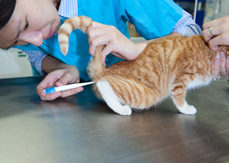Cats
Cats
Proper Care
Needs
Here’s a simple checklist to assist you in taking proper care of your cat
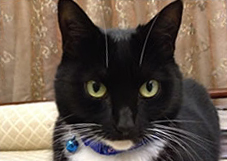
Basic equipment and setup
- Water bowl
- Food bowl
- Cat bed
- Washable blanket or towel for cat bed
- Litter box with litter
- Windows with grilles
- Shampoo
- Nail clipper
- Grooming supplies (e.g. brush, comb)
- Scratching post
- Toys
Basic care
- Access to clean and fresh water
- Adequate and nutritious food
- Regular grooming especially hair brushing for long-haired
Health matters
- Registered veterinarian consultation for regular checkups or medical treatment when the cat is sick / injured
- Basic flu / enteritis vaccination every year
- Regular deworming
- Hairball remedy as needed
- Flea prevention as needed
Above all, remember your cat needs tender loving care!
Feeding
What food to feed?
For kittens, there are manufactured high quality kitten food available. This applies to adult cats too. Consult your vet for recommendation of reliable cat food. Also, your cat should always have clean, fresh water at all times.
What food to avoid?
Well-formulated cat and kitten food available commercially should provide complete nutrition. Kittens who are weaned off queen’s milk and adult cats may be intolerant to lactose in milk. Lactose intolerance can cause diarrhoea in these kittens and cats. Therefore, avoid feeding cow’s milk to cats and kittens.
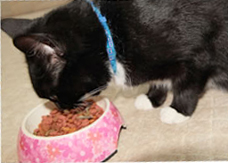
Cats are carnivores. They have very specific dietary needs that most human food may not meet. Some human food only provide partial diet thus predisposing these cats to malnutrition. Other human food is harmful to cats, common examples include alcohol, chocolates, coffee, grapes, garlic, onions, raisins, etc.
How often should I feed my cat?
For kittens that are 2 to 3 months old, feed them 4 times per day. They should be fed frequently and putting on weight steadily.
For kittens that are 3 to 6 months old, feed them 3 times per day.
For adult cats, feed them ad lib or two to three meals per day.
How much should I feed my cat?
It depends on your cat’s diet, bodyweight and activity level. Find out your cat’s ideal weight and body score from your vet. The feeding instructions per bodyweight can be found on the cat food can or packet. But make sure you don’t overfeed your cat. Obesity is a common problem and health problems such as diabetes or joint disease can occur.
What kind of food bowl to use?
It’s best to use food and water bowls made of stainless steel or ceramic as there have been studies that plastic bowls can retain smell that can cause resentment to feeding. Make sure your cat’s food and water bowls are kept clean.
Is it ok to give my cat treats?
It is ok to give your cat treats occasionally but you should limit the amount you give. Most packaged treats contain high levels of sugar and fats which are not healthy for your cat and may cause it to become overweight. So don’t overdo it.
Accommodation
You should ensure that your cat has enough space to walk around freely. You should also provide your cat with a cat bed covered by a clean and washable blanket or towel so that it can keep warm when the weather is cold. Wash the blanket or towel frequently.
Give your cat a litter box filled with clean litter to encourage normal urination. Make sure the litter box is placed away from where your cat eats and sleeps. Put it in a quiet and accessible place. If you have more than one cat, make sure each cat has at least one litter box.
Cats are solitary animals and avid climbers. Provide your cat with a safe and high place where it can climb, rest and hide, for example, the top of cupboards and shelves. But make sure your windows are gridded or barred to avoid “high-rise syndrome”.

If you decide for your cat to be an indoor-outdoor cat, you can safely do so by providing your cat with suitable preventive measures. These measures include vaccinations against common diseases, flea and parasite prevention and neutering your cat. Outdoor cats can get into fights with other free-roaming cats and dogs and become injured, hit by cars or lost.
Finally, make sure you keep harmful chemicals (such as washing powder, bleach, etc.) and food and substances that are poisonous and harmful for cats (such as chocolates, grapes, onions, strings, threads, anything linear) out of their reach. Strings, threads and anything linear can become harmful to cats as they have papillae on their tongues. Cats tampering with strings and threads can swallow them. This condition is called linear foreign body and can be lethal and requires surgical correction.
Cleaning and grooming
Cats are very clean animals. They often clean themselves with their tongue, therefore they rarely need a bath unless they get really dirty or have fleas. Brushing or combing your cat regularly will help keep its coat clean and reduce shedding. Be gentle when you brush your cat. For long-haired cats, ideally brush them daily to prevent hair mat. Other cats may need professional grooming.
Clean your cat’s litter box at least once daily, as cats prefer their own clean litter box. You can empty used litter, wash the box with a mild detergent and refill clean litter into the box regularly or at least twice a week.
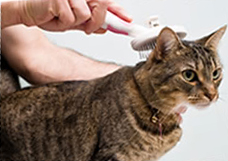
Cats have a natural instinct to scratch and to file their nails. When a cat scratches, the outer nail sheath is removed and the sharp, smooth claws below are exposed. Therefore, unless you do not mind your furniture being scratched, you need to provide your cat with a scratching post. The scratching post can be of various shapes but it should be solid and sturdy. Catnip can be added to the scratch post to entice scratching.

Interaction
Although cats can be quite independent, they are also very playful animals and many enjoy playing with toys and people. So if your cat enjoys human company, they may enjoy playing with laser pointer, catnip-filled or feathery toys. But remember to allow it to interact with you on its terms as cats sometimes like to be left alone.
Cats are nocturnal which means they are more active at nighttime. They can sleep up to 18 hours a day but when awake they are active and need to vent their energy. If you provide your cat with safe toys to play with, it should be able to get enough exercise and entertain itself.
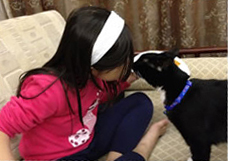
Training
Unlike dogs who enjoy training, cats don’t always do. So do not expect cats to come to you when you call them, especially when they are not in the mood. They may not be able or willing to respond to commands or do tricks like dogs. You must be understanding and patient with them. However, they are easier to toilet-train as they take to the litter box naturally.
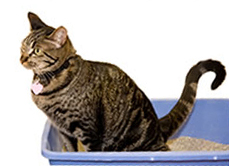
Medical Care and Vaccination Schedule
Initial check-up
After you get your cat, you should take it to a registered veterinary surgeon (vet) immediately for an initial check-up. The vet will give you advice on the vaccinations, deworming programme, anti-parasitic treatment and other preventative medication your cat will need to protect it from the following:
- common infectious diseases;
- common worms such as hookworm, roundworm, tapeworm and whipworm;
- common parasites such as fleas, lice, mites and ticks;
- heartworm disease.
You can also consult your vet for health care tips for your cat.
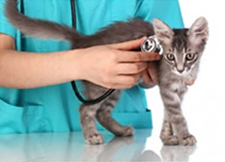
Annual health check
After the initial check-up, you should take your cat to the vet at least once a year for an annual health check to ensure that it is healthy.
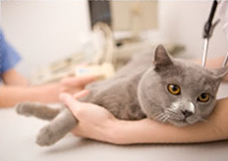
Medical treatment for injuries / illnesses
Just as you need to consult a doctor when you fall sick or are injured, in the same way, you need to bring your cat to a vet if it is ill or injured. Remember, seek early treatment for any injuries and/or illnesses your cat has. If you notice any unusual signs or behaviour in your cat, they might be indications that your cat is sick. If your cat displays any of the following symptoms, you should contact your vet.
- appears weak and tired
- has dull or weeping eyes and/or nasal discharge
- is coughing and/or wheezing
- is sneezing
- is open mouth breathing
- has fever
- has lost appetite for more than one day, or sooner for young animals
- is painful on touch
- has seizure or lost consciousness
- has diarrhoea
- vocalise excessively
- has vomiting
- has drastic changes in water consumption or weight
- has obvious hair loss
- has cuts/injuries/wounds
- is limping
- has lumps or bumps on the body
- has sore or dirty ears
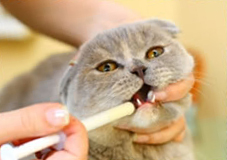
Always consult a registered vet
Some pet owners think it is too expensive to consult a vet and believe staff from pet shops can give them advice on the health of their pets. However, this is a very wrong concept. Also, pet owners should not use human prescription drugs to treat pets on their own. Some human medications can be fatal to pets. Remember, only a registered vet can provide professional advice regarding the health of your pet.
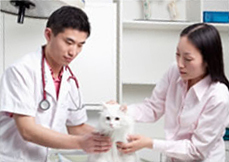
Vaccines that cats need
It is best to consult your vet so they can help you decide which vaccines are the most appropriate for your cat. Make sure you tell your vet about your cat’s current medical problems, lifestyle, living environment, medical history and any medications your cat is receiving.
Vaccines that are recommended for all cats include feline panleukopenia (infectious enteritis), feline viral rhinotracheitis (feline herpesvirus) and feline calicivirus. If your cat goes outdoors, it is recommended that you give your cat the feline leukemia vaccine and rabies vaccine as well.
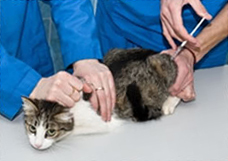
Typical vaccination schedule for cats
| Types of vaccines | When to receive the first dose | When to receive the second dose | Booster vaccination** |
|---|---|---|---|
| Combination vaccine* | 6 to 8 weeks of age | 12 to 16 weeks of age | According to veterinarian recommendation |
| Feline leukemia | 13 weeks of age | 16 weeks of age | Yes for cats at risk |
| Rabies | 12 weeks of age | Every 3 years | Dependent on type of vaccine |
* A combination vaccine includes feline panleukopenia (infectious enteritis), feline viral rhinotracheitis and feline calicivirus.
** Whether your cat needs to be vaccinated every year depends on the type of vaccine.
Always consult your vet to determine the best vaccination schedule for your cat. Bear in mind that recommendations vary according to the age, breed, health status of your cat, the potential of your cat to be exposed to the disease, the type of vaccine, whether your cat is an indoor-outdoor cat, whether your cat lives in a multiple-cat environment and the geographical area where your cat lives or may visit.
Points to note when your cat receives vaccination
When your cat receives vaccination, make sure that you tell the vet if your cat has any history of allergic reactions to any drugs or vaccinations.
If your cat has been ill or displaying symptoms such as vomiting and/or diarrhoea, etc. in the past few days, your cat should receive the vaccination later, preferably after it has fully recovered. This should be discussed with the vet.
Depending on individual cats, some may develop allergic reactions to the vaccination, but the chance of that is quite low. Symptoms that may appear during the first few hours after the injection include vomiting, generalised skin hypersensitivity (rash) and/or localised swelling at the injection site. If the above symptoms are noted, you should take your cat to a private veterinary clinic for immediate treatment.
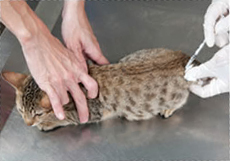
Toxoplasmosis
What is toxoplasmosis?
Toxoplasmosis is a parasitical disease caused by a protozoan named Toxoplasma gondii (T. gondii). The parasite can affect all mammals including humans. Cats are definitive hosts for T. gondii which means the parasite can only complete its life cycle and produce eggs when infecting a cat. The eggs will be excreted in the infected cat's faeces. As cats are the primary host for T. gondii, many people worry that their cats will infect them. Pregnant women are especially concerned about T. gondii infection as it can lead to miscarriage, premature birth or infants with permanent neurological disorders. However, if you study the facts on transmission* of this parasite, you will realise that the risk of acquiring Toxoplasmosis through contact with cats is minimal.
(*Please continue to read the rest of this article to find out more.)

How do cats get infected?
Cats can be infected by
- eating raw or undercooked meat containing the T. gondii cysts or infected mammalian prey such as mice;
- exposure to oocysts (eggs) found in soil that is contaminated by an infected cat’s faeces.
When a cat eats raw meat or an infected prey, the parasite is released into the cat’s digestive tract. The Toxoplasma organisms then multiply in the cat’s intestinal wall and produce oocysts. These oocysts are then excreted in large numbers in the cat’s faeces. Cats that have not been exposed to T. gondii before will usually start shedding oocysts 3 to 10 days after ingesting infected food or substances. The shedding will last for 2 to 3 weeks. Oocysts excreted in a cat’s faeces are not instantly infectious to humans and other animals. Oocysts must go through a process named sporulation, which takes 1 to 5 days dependent on environmental conditions. Once the oocysts are sporulated, they are infectious to cats, humans and other animals. Humans and animals can become infected through ingesting sporulated oocysts.
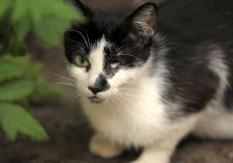
What are the symptoms of toxoplasmosis in cats?
Most cats will not show any symptoms even if infected. Usually, it is mainly kittens and young adult cats that show symptoms. Early signs are general, such as lassitude, fever, lethargy and poor appetite. Some cats may develop pneumonia and have difficulty in breathing. Toxoplasmosis can also affect the eyes and the central nervous system causing blindness, inflammation of the retina, seizures, etc.
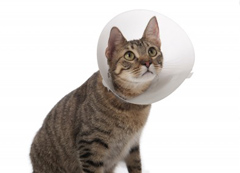
How do humans get infected?
People can get infected through contact with oocyst-contaminated soil, eating undercooked infected meat especially lamb and pork, eating unwashed fruits and vegetables and consuming unpasteurised dairy products such as goat’s milk. T. gondii can also be transmitted from pregnant woman to unborn baby if the mother got infected during pregnancy.

What are the symptoms of toxoplasmosis in humans?
- Fatigue
- General flu-like symptoms
- Headaches
- Muscular aches
- Swollen lymph nodes in the neck

Who are at risk of toxoplasmosis?
- Infants
- People with a compromised immune system, for example, people with AIDS, people on chemotherapy, elderly people, etc.
- Pregnant women (due to the risk to their foetus)



How can I prevent toxoplasmosis?
- Do not eat raw or undercooked meat. Make sure your food is thoroughly cooked before you eat them.
- Do not drink unpasteurised milk or consume any unpasteurised dairy products such as cream and cheese made from unpasteurised milk.
- Always wash fruits and vegetables (including pre-washed salads) thoroughly before you eat them, especially when you are eating them raw.
- Always wash your hands with warm soapy water before preparing food and after handling food especially after handling raw meat. After you have finished cooking, wash your hands and all food preparation surfaces and cooking utensils thoroughly.
- Wash hands thoroughly before eating.
- Do not drink water from the environment unless it is boiled.
- Always wear gloves when gardening or handling soil or sand. Wash your hands afterwards in case you have come into contact with the cat’s faeces in the soil.
- Keep your children’s sand box covered to prevent cats from using it as a litter tray.
- If you have a cat, wear gloves when you empty the litter tray. Remember to wash your hands thoroughly afterwards.
- Empty the litter tray daily to minimise the risk of infection as the oocysts excreted in a cat’s faeces are only infectious to humans and other animals after sporulation, which takes 1 to 5 days dependent on environmental conditions.
- Seal cat litter in a plastic bag before disposal.
- Wash the litter tray with detergent and boiling water regularly. Leave boiling water in tray for 5 to 10 minutes. The boiling water will kill the oocysts.
- Only feed cats cooked or commercial cat foods. Do not give them unpasteurised milk. Never feed raw or undercooked meat to cats.
- Keep your cat indoors to prevent it from roaming and hunting.
- Do not allow cats to use children’s play area as their litter tray.
- If you have been in contact with sheep at farms or have visited outdoor places where there are animals, wash your hands thoroughly afterwards.

If I am planning to have a baby or I am pregnant now, how can I reduce the risk of transmission of toxoplasmosis from my cat?
In addition to following the steps under “How can I prevent toxoplasmosis?”, you should take the following precautions as well:
- Do not introduce new cats, in particular stray cats, to your home during your pregnancy.
- Do not handle soil where cats have access.
- Avoid contact with your cat’s litter tray. Ask someone else to clean the litter tray for you while you are pregnant.
- Do not eat cured meats such as parma ham and salami during pregnancy.
- Do not handle new born lambs while you are pregnant.
Is it safe for a pregnant woman to have a pet cat?
As long as you take the preventative measures mentioned above, the risk of getting toxoplasmosis from a pet cat is minimal.
A pregnant woman is more likely to get toxoplasmosis from eating undercooked meat than from contact with pet cats. As mentioned above, recommended practice is to avoid contacting cat’s faeces. This can be done either by getting another person to clean the litter tray or if needed, to wear gloves and clean litter tray every day. One should always wash hands thoroughly after handling a cat or fomite. If you have specific concerns or further questions about toxoplasmosis, speak to your vet or doctor.
